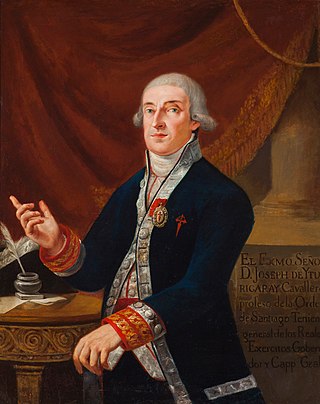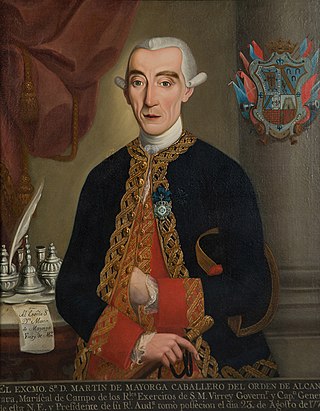A Real Audience, or simply an Audience, was an appellate court in Spain and its empire. The name of the institution literally translates as Royal Audience. The additional designation chancillería was applied to the appellate courts in early modern Spain. Each audiencia had oidores.

Juan de Palafox y Mendoza was a Spanish politician, administrator, and Catholic clergyman in 17th century Spain and a viceroy of Mexico.

The Spanish East Indies were the colonies of the Spanish Empire in Asia and Oceania from 1565 to 1901, governed through the captaincy general in Manila for the Spanish Crown, initially reporting to Mexico City, then later directly reporting to Madrid after the Spanish American Wars of Independence.
Eugenio Fernández Granell, recognised as the last Spanish surrealist, was an artist, professor, musician and writer.

The Captaincy General of Guatemala, also known as the Kingdom of Guatemala, was an administrative division of the Spanish Empire, under the viceroyalty of New Spain in Central America, including present-day Costa Rica, Nicaragua, Honduras, El Salvador, Guatemala, and the Mexican state of Chiapas. The governor-captain general was also president of the Royal Audiencia of Guatemala, the superior court.

José Joaquín Vicente de Iturrigaray y Aróstegui, KOS was a Spanish military officer and viceroy of New Spain, from 4 January 1803 to 16 September 1808, during Napoleon's invasion of Spain and the establishment of a Bonapartist regime in Spain. His plans to form a provisional autonomous government led to his arrest and deposition.

Payo Enríquez de Rivera y Manrique, O.E.S.A., was a Spanish Augustinian friar who served as the Bishop of Guatemala (1657–67), Archbishop of Mexico (1668–1681) and Viceroy of New Spain.

Pedro de Castro y Figueroa y Salazar, 1st Duke of la Conquista, 1st Marquess of Gracia Real, KOS, OSJ was a Spanish military officer and viceroy of New Spain.

Matías de Gálvez y Gallardo, KOS was a Spanish general, the Captain General of Guatemala from April 1779 to 3 April 1783, and Viceroy of New Spain from 29 April 1783 to 3 November 1784.

Martín de Mayorga Ferrer was a Spanish military officer, governor of the Captaincy General of Guatemala, and interim viceroy of New Spain.
Alonso de Maldonado Diez de Ledesma, was a Spanish lawyer and a member of the second Real Audiencia of Mexico, which governed New Spain from January 10, 1531 to April 16, 1535. He was also president of the first Real Audiencia of Guatemala, and in that capacity interim governor of Guatemala from 1536 to September 15, 1539. He was governor of Guatemala a second time, from 1542 to 1548.
The Real Audiencia of Mexico or Royal Audiencia of Mexico was the highest tribunal of the Spanish crown in the Kingdom of New Spain. The Audiencia was created by royal decree on December 13, 1527, and was seated in the viceregal capital of Mexico City. The First Audiencia was dissolved by the crown for its bungling and corruption and the crown established the Second Audiencia in 1530. This was supplanted by the Viceroyalty of New Spain in 1535. A new Audiencia was created in Guadalajara in western Mexico in 1548.
The Real Audiencia of Guadalajara, was the highest tribunal of the Spanish crown in what is today northern Mexico and the southwestern United States in the Viceroyalty of New Spain. It was created by royal decree on February 13, 1548, and was originally located in Compostela and permanently seated in Guadalajara in 1560. Its president was the chief political and executive officer of the district, subordinated only to the Viceroy.
The Real Audiencia of Manila was the Real Audiencia of the Spanish East Indies, which included modern-day Guam, the Northern Mariana Islands, Palau, Micronesia and the Philippines. Similar to Real Audiencias throughout the Spanish Empire, it was the highest tribunal within the territories of the Captaincy General of the Philippines, a dependency of the Viceroyalty of New Spain.
The Royal Audience and Chancery of Panama in Tierra Firme was a governing body and superior court in the New World empire of Spain. The Audiencia of Panama was the third American audiencia after the ones of Santo Domingo and Mexico. It existed three times under various guises since it first creation in 1538 until its ultimate abolition in 1751.
The Real Audiencia of Santiago de Guatemala, simply known as the Audiencia of Guatemala or the Audiencia of Los Confines, was a Real Audiencia in the Imperial Spanish territory in Central America known as the Captaincy General of Guatemala (1609-1821). The Audiencia's presiding officer, the president, was the head of the government of the area. The Audiencia was initially created by decrees of November 20, 1542 and September 13, 1543, and had its seat in Antigua Guatemala.
José de Rezabal y Ugarte (1747–1800) was a Spanish lawyer and judge and jurist. He was born in Vitoria on July 19, 1800 and died in Santiago, Chile. He served as Spanish governor of Chile, on an interim basis, from 24 May to 18 September 1796. As judge and mayor over crime in Lima in 1781, he led the case against Túpac Amaru II, writing the judgment which condemned to death by hanging him and several of his followers, as well as penalties in prisons in Africa, Callao and Valdivia for many others.
Sebastián Garcilaso de la Vega y Vargas was a Spanish conquistador and colonial official. He fathered a son, the mestizo chronicler Garcilaso de la Vega, with the Inca princess Isabel Chimpu Occlo.

Ramón Posada y Soto was a Spanish jurist, writer and academic who served as the first president of the Supreme Court from 1812 to 1814.

José Alejandro de Aycinena y Carrillo was a Spanish military officer and politician who served as the Colonial Intendant of the Intendancy of San Salvador from 1811 to 1812.








